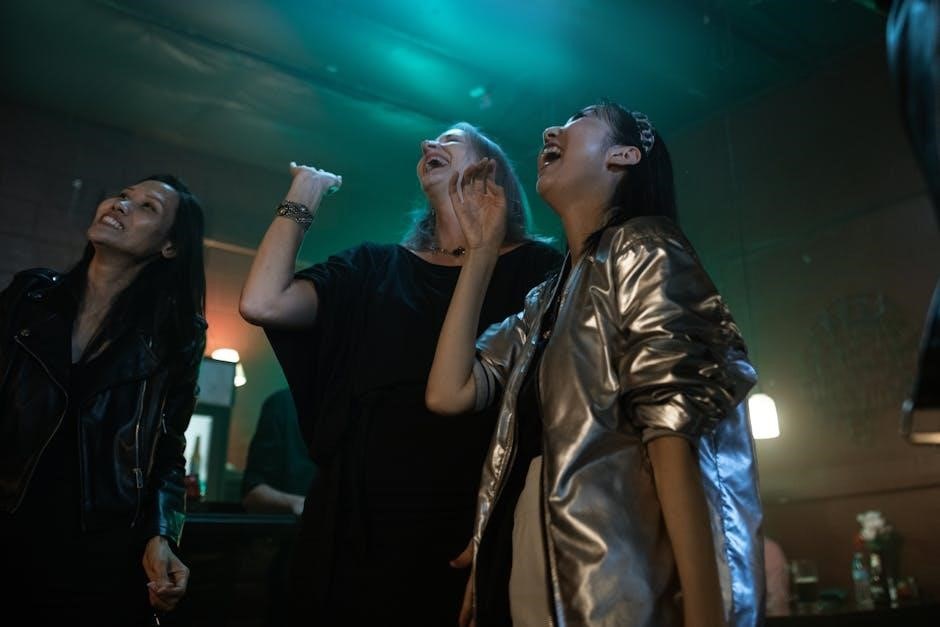the joy luck club book pdf
Amy Tan’s The Joy Luck Club (1989) explores the complex relationships between four Chinese immigrant mothers and their American-born daughters in San Francisco.
Overview of the Novel
The Joy Luck Club by Amy Tan is a masterfully woven narrative that explores the lives of four Chinese immigrant mothers and their American-born daughters in San Francisco. The book is structured into four sections, each containing four chapters, creating a mahjong-inspired framework. Through interconnected stories, Tan delves into themes of cultural identity, mother-daughter relationships, and the immigrant experience. The novel alternates between the mothers’ memories of their past in China and their daughters’ struggles to navigate American life. Rich with emotional depth, the book highlights the challenges of bridging cultural divides and the universal quest for understanding and belonging.
Importance of the Book in Asian American Literature
The Joy Luck Club is a seminal work in Asian American literature, offering a poignant exploration of the immigrant experience and cultural identity. Amy Tan’s novel has been instrumental in giving voice to the Asian American community, particularly the experiences of Chinese American women. By bridging the gap between generations and cultures, the book fosters understanding and empathy. Its authentic portrayal of the challenges faced by immigrants and their descendants has resonated widely, making it a cornerstone of contemporary literature. The novel’s impact extends beyond its narrative, influencing a wave of Asian American writers and solidifying its place as a classic in the genre.

Author Background: Amy Tan
Amy Tan, born in 1952 to Chinese immigrant parents, is a celebrated Chinese American author known for exploring themes of cultural identity and family dynamics.
Amy Tan’s Inspiration for the Novel
Amy Tan drew inspiration for The Joy Luck Club from her own experiences as a child of Chinese immigrants. Her complex relationship with her mother and the cultural gaps she observed between generations fueled her storytelling. Tan wanted to explore the emotional and cultural struggles faced by immigrant families, particularly the tension between preserving heritage and adapting to a new identity. Her personal history and observations of the Chinese American community shaped the novel’s themes of mother-daughter relationships and the immigrant experience. The mahjong game, a symbol of tradition and connection, also influenced the book’s structure and narrative flow.
Her Experience as a Child of Immigrants
Amy Tan’s upbringing as a child of Chinese immigrants deeply influenced her writing. She often felt caught between her parents’ traditional values and her own Americanized identity. Tan’s parents, who fled China, struggled to adapt to life in the U.S., while she and her siblings embraced American culture. This duality shaped her perspective on cultural identity and generational conflict. Her experiences of navigating two worlds inspired the nuanced portrayals of mothers and daughters in The Joy Luck Club, reflecting the challenges of maintaining heritage while seeking belonging in a new society.

Plot Structure and Organization
The novel is structured like a mahjong game, with four parts divided into four chapters each, creating sixteen interconnected stories. These stories weave together the mothers’ pasts in China and their daughters’ lives in America, highlighting cultural and generational gaps.
The Mahjong Game as a Symbolic Framework
The mahjong game serves as a symbolic framework, mirroring the structure of the novel. The game, with its four parts and sixteen chapters, represents the four mothers and their four daughters, each contributing to the narrative. Mahjong symbolizes chance, strategy, and harmony, reflecting the characters’ lives. It also signifies cultural preservation, as the mothers maintain their heritage through the game. The game’s cyclical nature echoes the recurring themes of memory and tradition, bridging the gap between the mothers’ pasts and their daughters’ futures. This framework underscores the interconnectedness of their stories and the universal quest for understanding and belonging.
Interconnected Stories and Their Significance
The novel’s structure weaves together sixteen interconnected stories, alternating between the lives of four Chinese immigrant mothers and their American-born daughters. These narratives explore the emotional and cultural gaps between generations, revealing the complexities of mother-daughter relationships. The interconnectedness highlights how the past shapes the present, as the mothers’ experiences in China influence their daughters’ struggles with identity in America. This interwoven format allows Tan to examine themes of cultural clash, belonging, and the immigrant experience. By juxtaposing their stories, the novel underscores the universal quest for understanding and the enduring power of familial bonds, creating a rich tapestry of shared history and individual growth.

Major Characters in the Novel
The novel centers around eight key characters: four Chinese immigrant mothers (Suyuan, Lindo, Yingying, and An-mei) and their four American-born daughters (Jing-mei, Waverly, Lena, and Rose).
The Mothers: Suyuan, Lindo, Yingying, and An-mei
The mothers, Suyuan, Lindo, Yingying, and An-mei, are Chinese immigrants who fled their homeland in the 1940s, each carrying traumatic memories and cultural values. Suyuan, the founder of the Joy Luck Club, embodies resilience and hope, while Lindo uses cunning to survive her arranged marriage. Yingying’s quiet strength hides a tragic past, and An-mei’s life is marked by sacrifice and a quest for spiritual balance. These women struggle to bridge the gap between their traditional upbringings and their American daughters’ modern lives, often leading to misunderstandings and emotional distance. Their stories reveal the depth of their love and the challenges of preserving heritage in a new world.
The Daughters: Jing-mei, Waverly, Lena, and Rose
The daughters—Jing-mei, Waverly, Lena, and Rose—grapple with their dual identities as American-born women of Chinese descent. Jing-mei seeks to understand her mother’s past and her own identity, while Waverly deals with the pressure of living up to her mother’s expectations. Lena struggles with self-worth and marital issues, and Rose faces racial discrimination and self-discovery. Each daughter navigates the tension between her mother’s traditional values and her own Americanized aspirations, leading to moments of conflict and eventual understanding. Their journeys highlight the challenges of cultural assimilation and the universal quest for belonging and self-acceptance.

Key Themes Explored in the Book
The novel delves into themes of mother-daughter relationships, cultural identity, generational conflict, and the immigrant experience, highlighting the struggle to balance tradition and modernity.
Mother-Daughter Relationships and Cultural Conflicts
The novel vividly portrays the intricate and often strained relationships between Chinese immigrant mothers and their American-born daughters. The mothers, shaped by their traumatic pasts in China, struggle to understand their daughters’ Westernized values. In turn, the daughters grapple with their dual identities, caught between honoring their heritage and embracing American culture. These conflicts are compounded by generational and cultural gaps, leading to misunderstandings and emotional distance. Through these dynamics, Tan highlights the universal challenges of immigration and the enduring bonds of family, offering a poignant exploration of love, sacrifice, and the quest for mutual understanding.
The Struggle for Identity and Belonging

The novel delves into the universal theme of identity, particularly through the experiences of the American-born daughters. Caught between their Chinese heritage and American upbringing, they grapple with conflicting cultural expectations. The daughters often feel alienated, struggling to reconcile their mothers’ traditional values with their own modern, Westernized identities. This internal conflict is further complicated by societal pressures and generational gaps. Through their journeys, Tan illustrates the pain of self-discovery and the quest for belonging. Ultimately, the characters find solace in understanding their mothers’ pasts, allowing them to embrace their dual identities and forge a sense of unity with their cultural roots.
The American Dream and Its Challenges
The novel portrays the pursuit of the American Dream through the lens of Chinese immigrants seeking better lives in the U.S. The mothers, having fled China, envision prosperity and opportunities for their daughters. However, cultural barriers, societal racism, and internalized conflicts complicate their aspirations. The daughters, caught between their mothers’ expectations and their own American identities, struggle to reconcile these opposing worlds. While the Dream promises success and happiness, the characters face disillusionment, highlighting the gap between idealized aspirations and the harsh realities of cultural assimilation. This theme underscores the emotional and cultural tensions inherent in the immigrant experience, revealing the bittersweet nature of their pursuits.

Cultural Significance of the Novel
The Joy Luck Club highlights the Chinese American experience, offering a poignant exploration of cultural identity, immigration, and family dynamics, resonating deeply with diverse audiences worldwide.
Representation of Chinese American Experiences
The Joy Luck Club offers a profound portrayal of Chinese American life, delving into the struggles and triumphs of immigrant families. The novel captures the cultural tensions between first-generation mothers, who cling to their Chinese heritage, and their American-born daughters, navigating identity in a new world. Through vivid storytelling, Tan explores themes of cultural preservation, generational gaps, and the immigrant experience. The mahjong club itself symbolizes community and tradition, while the daughters’ journeys reflect the universal quest for belonging. Set in San Francisco’s Chinatown, the book vividly portrays the duality of life in America, blending memories of China with the realities of a new homeland. This authentic representation has made the novel a cornerstone of Chinese American literature, resonating with readers seeking to understand the complexities of cultural identity and integration.
The Role of Chinatown as a Cultural Hub
Chinatown serves as a vibrant cultural sanctuary for the immigrant families in The Joy Luck Club, preserving traditions and fostering a sense of community. The novel highlights Chinatown’s role in maintaining cultural identity, with its familiar sights, sounds, and smells evoking a sense of home for the mothers. The mahjong club, a central symbol, embodies this cultural hub, where traditions are shared and stories are exchanged. Chinatown’s significance extends beyond geography, representing a bridge between the old world and the new, where immigrant families navigate their dual identities. This portrayal underscores the importance of cultural spaces in sustaining heritage and fostering belonging for Chinese Americans.
Reception and Impact
The Joy Luck Club received widespread critical acclaim for its nuanced portrayal of mother-daughter relationships and cultural identity, becoming a landmark in Asian American literature.
Critical Acclaim and Popularity
The Joy Luck Club garnered immediate acclaim upon its release in 1989, praised for its insightful exploration of cultural identity and intergenerational relationships. Reviewers lauded Amy Tan’s vivid storytelling and emotional depth, resonating with readers across diverse backgrounds. The novel became a New York Times bestseller and solidified its place as a contemporary classic. Its popularity stems from its relatable themes and authentic voices, making it a staple in Asian American literature and a favorite among book clubs. The novel’s success also led to a 1993 film adaptation, further cementing its cultural impact and enduring appeal to audiences worldwide.
The 1993 Film Adaptation
The film adaptation of The Joy Luck Club, directed by Wayne Wang, brought Amy Tan’s novel to life, capturing its emotional depth and cultural richness. Produced by Oliver Stone, the movie featured a predominantly Asian cast, including Ming-Na Wen, Tamlyn Tomita, and France Nuyen. It remained faithful to the book’s themes of identity, family, and cultural conflict, resonating with audiences. The adaptation was praised for its authentic portrayal of Chinese American experiences, though some critics noted its condensed narrative. Despite this, the film became a landmark in Asian American cinema, introducing the story to a broader audience and solidifying the novel’s legacy. Its impact endures as a cultural milestone.
The Joy Luck Club remains a landmark in Asian American literature, offering profound insights into cultural identity, family dynamics, and the immigrant experience, leaving a lasting legacy.
Legacy of “The Joy Luck Club”
The Joy Luck Club has left an indelible mark on contemporary literature, inspiring countless authors to explore intergenerational and cultural themes. Its exploration of identity, family, and immigration resonates universally, making it a cornerstone of Asian American literature. The novel’s success paved the way for diverse voices, challenging stereotypes and fostering a deeper understanding of the immigrant experience. Its impact extends beyond literature, influencing film and cultural narratives, ensuring its relevance for future generations. Amy Tan’s work continues to be celebrated for its emotional depth and its ability to bridge cultural divides, solidifying its place as a modern classic.
Its Influence on Contemporary Literature
The Joy Luck Club has profoundly influenced contemporary literature by empowering Asian American writers to explore their cultural identities. Its nuanced portrayal of intergenerational conflicts and immigration experiences inspired authors like Celeste Ng and Ocean Vuong. The novel’s non-linear, interconnected structure has become a model for storytelling, encouraging experimentation in narrative forms. By challenging stereotypes and amplifying underrepresented voices, The Joy Luck Club has reshaped the literary landscape, fostering a deeper appreciation for diverse perspectives. Its impact continues to resonate, inspiring new generations of writers to explore themes of identity, culture, and belonging.